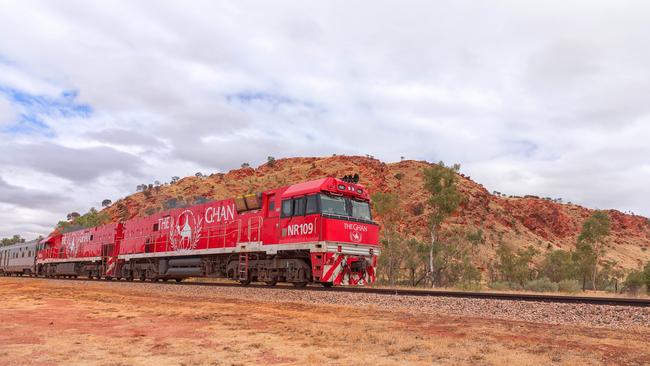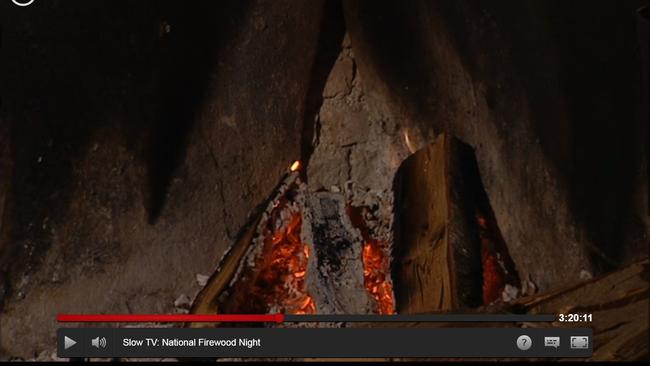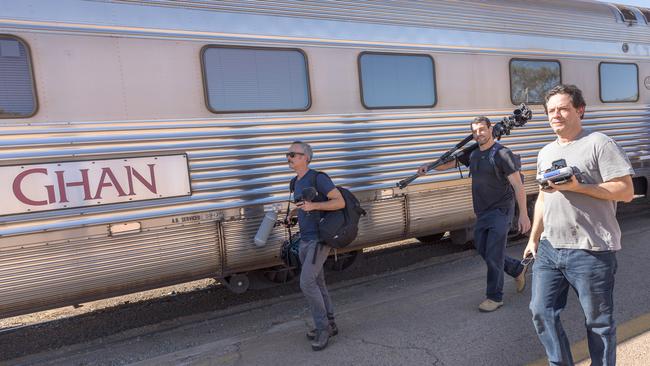The Ghan: Australia’s Greatest Train Journey — SBS joins slow TV trip
SBS has jumped on the slow-TV phenomenon with a three-hour broadcast of a journey on the famous Ghan.

It’s 10pm on a sticky December evening, and I’m sitting in front of a roaring fire. Some poetry is being read and folk music can be heard in the background, but mostly there is just fire. Thrilled, I watch as another log is thrown on and the flames leap before my eyes.
It’s a transfixing experience. After three pleasant hours, I switch it off and head to bed. As you might have guessed, this is no ordinary fire. Rather, it’s a television program called National Firewood Night, streaming on Netflix. And if your first reaction is “how boring!” consider that when it was originally broadcast in Norway, almost a million people — about 20 per cent of the population — tuned in.

National Firewood Night is one example of a burgeoning genre known as slow TV. It prompts audiences to savour slowly unfolding relaxing scenarios such as salmon fishing, knitting or reindeer migration; alternatively, they can survey natural vistas from scenic train or boat trips.
Shot in real time and uninterrupted by advertising, it is known for its calm visual style and is pitched as an antidote to the violent and sexually graphic fare we are increasingly offered on TV, not to mention the mind-numbing wasteland of free-to-air reality TV.
Almost a decade after this phenomenon emerged in the Nordic countries, it comes to Australia with The Ghan: Australia’s Greatest Train Journey, commissioned by SBS and appearing on the channel tomorrow night as a three-hour broadcast depicting the Adelaide-to-Darwin route. A 17-hour dawn-to-dusk version will be screened on SBS Viceland, On Demand and Facebook.
The program’s director and executive producer, Adam Kay, who also produced the recent Foxtel Arts series The Archibald, says a number of subjects were considered for Australia’s first slow TV production. “SBS set us a challenge of finding Australia’s greatest slow television experience. I thought first and foremost it had to be something iconic that would capture everyone’s imagination,” he says.
“We did extensive research and actually pitched 10 ideas to them, including the Spirit of Tasmania ferry trip, or a boat up the Daintree River — but nothing stood out as much as The Ghan.”

Kay’s crew used 15 cameras, plus a helicopter, to capture the footage. And, like BBC Four slow TV productions of recent years, it is augmented by occasional graphics. “Every three or four minutes, depending on where we are on the journey, a story will pop up in the form of a beautifully animated 3-D graphic that looks like it’s transposed into the ground or into the earth,” Kay says.
“It might be a story about the Afghans, from where The Ghan gets its name, or where the first camel was on the route, or about the Chinese coolies that came to mine the gold. There’s no narration or music, just beautiful sound scape and graphics.”
Kay says that at this time of year in particular, TV audiences feel “oversaturated” with sex, violence and reality TV.
“This is just a beautifully hypnotic experience that takes you through the middle of Australia. I think we forget as Australians how beautiful our country is,” he says.

Catharine Lumby, professor of media at Sydney’s Macquarie University, says slow TV’s surprising popularity is another example of the divergence between audiences and what TV programmers have traditionally believed they want to watch.
“I think they have underestimated our attention spans and may not understand us as well as they think,” she says.
“I love that it has that connection to materialist, avant-garde filmmaking like Andy Warhol’s Sleep, his 1964 film which showed six hours of poet John Giorno sleeping.
“We live in world deluged with social media, bombarded by emails, and driven to distraction by endless choices; and the escalation of sex and violence on TV becomes a bit banal at a certain point. I just wonder if slow TV is linked in a deep sociological way with a desire to switch off from all that.”
But aren’t we fooling ourselves? We aren’t actually sitting around a log fire with a million Norwegians; we are still sitting in front of the TV. To borrow the formulation of American political scientist Robert Putnam, who decried the loss of interpersonal contact in society, aren’t we still “bowling alone”?
“My view is a bit against the grain, and everywhere I go I hear parents complaining that they can’t get their son or daughter off their phones or computers,” Lumby says.
“But the screens are the real world. Every new technology has led to panicked claims that it will be ruinous for society. For me, it’s less about the screen or out the window, and more about what are you looking at.
“I believe Warhol was trying to make the statement that we look but we don’t observe.”
The Ghan: Australia’s Greatest Train Journey, tomorrow, 7.30pm, SBS.
Slow TV from Norwegian broadcaster NRK, including National Firewood Night, is available to stream on Netflix.



To join the conversation, please log in. Don't have an account? Register
Join the conversation, you are commenting as Logout